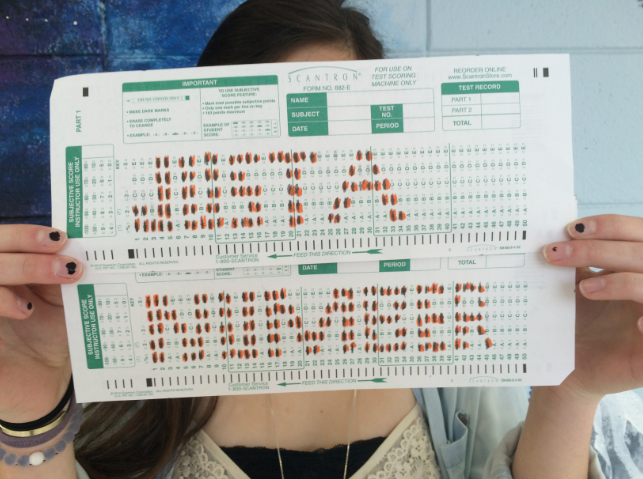More than just a number: College admissions dehumanizes students
Upon finishing the ACT, I, like many other college-hopeful juniors, came to the stark realization that the booklet sitting before me — replete with filled in circles and marks — served as the pathway to my future. Members of my generation, especially in the Mequon-Thiensville area, distinguish themselves as walking ACT scores. We are no longer just good students: we are identified as a number on a 36-point scale.
The desire to achieve a mere number — an all-consuming task — moves to the forefront of every student’s college plans. Families spend thousands of dollars for rigorous tutoring programs all to achieve a number. The ACT transforms humans into cattle branded with numbers ranging from one through 36. However, the test is not to blame; college admissions practices are the true culprits of the number-frenzy. As Adam Grant asserts in his New York Times article, “the college admissions system is broken,” and rather than strictly admitting “achievement robots,” colleges should focus on more individual qualities and skills of students, as well as a student’s leadership capabilities and character.
Albeit the ACT does, to a certain degree, according to the ACT.org, measure “what [a student] has learned in high school,” the information presented on the ACT test consists of many trivial topics learned in previous education levels, such as middle school and even elementary school. The trivial questions require great deals of memorization, especially since the skills are not always applicable to present learning.
In the crux of the matter, the fairness of the ACT and SAT tests also comes into question. A cartoon, by Alexander Russo, perfectly depicts the disadvantages some students have compared to other while being assessed with standardized tests. The cartoon, titled “Climb that Tree,” shows a variety of animals, ranging from elephants to goldfish, being asked to climb a tree for their final exam. Obviously, some of the animals are at a great advantage, the bird and the monkey, while others, the seal and the goldfish, find themselves greatly disadvantaged. This depiction accurately represents students who excel in other areas, such as art, for example, and their position of disadvantage while taking the ACT test. Some talents simply cannot be tested in a test booklet.
Additionally, the ACT website suggests that the best way to study for the test is to “take challenging courses in high school;” however, the assertion does not take a variety of course options into consideration. AP Government and Politics, for example, proves to be a challenging high school course. While the information obtained in AP Gov. poses a challenge to learn, that same information offers no help in any section of the ACT. Due to these factors, it is reasonable to conclude that the ACT measures, as Grant said, “rote knowledge.”
To solve this pressing issue, colleges should adopt more comprehensive evaluation systems for admitting students similar to processes used to hire employees in a professional setting. While plenty of prospective college-goers can boast a, according to Julie Park, author of “A Perfect SAT Score is Not Enough,” “golden ticket” satiated with “a perfect or near-perfect SAT score — along with appropriate extracurricular activities, a top class ranking and great Advanced Placement test scores,” not all of these students necessarily possess the skills that lead to a successful career after graduation.
According to Forbes.com, employers prioritize skills such as the “ability to work in a team” and “the ability to communicate verbally with people inside and outside an organization,” over skills and data held in high regard during the admissions process. The aim of colleges is to prepare students to enter the workforce and to ensure graduates make positive contributions to society. To achieve this feat, colleges should search for students possessing skills such as effective leadership, a drive to succeed and creativity, rather than the ability to memorize and look good on paper. To prove worthy of admittance, applicants should have to prove their skill set in a variety of ways.
Effective leadership, an invaluable skill, can be proven through leadership positions a student held while in high school. Harvard University, a world renowned university, highlights “genuine commitment” to a activity of a “leadership role” as a large factor toward admittance. While being a mere member of the ski team provides a good addition to an application, being a four-year member and/or captain of that same ski team looks much better. Captains practice skills revered in the work world: the ability to manage others, the ability to provide guidance and direction to others, and the ability to cooperate with others to achieve a common goal. As Tara Isabella Burton, journalist for The Atlantic asserts, leadership positions, in contrast to “merely average” participation, “display intangible merit.”
While difficulties arise when attempting to measure some qualities, such as drive to succeed, drive can be substantiated by the tasks a student decides to tackle. Harvard asks that its applicants stretch themselves and “[take] full advantage of opportunities” such as “academic pursuits, full-time or part-time employment, or other areas.” Students who saturate their schedule with myriad AP classes and leadership positions, as mentioned previously, display more evidence of an internal drive than a student with a high ACT score and an average class load.
Additionally, internships and jobs that require a student to take on an onerous workload outside of school illustrate the drive of a student. Since that work is not required, the workload suggests that the student takes on these tasks to further develop his or her skills and resume because he or she wants to, not because colleges require prospective students to be involved in these activities.
Creativity, unlike leadership and drive, can be blatantly displayed through projects and other tangible pieces of a student’s work. Colleges should require students to present a portfolio of their work, complete with essays, projects, etc. Portfolios, similar to the traditional college essay, cast a different light on a student’s potential, and portfolios highlight a student’s talents, which may cast them above the herd of other applicants.
On the subject of evaluating applicants based on creativity, Grant claims, “[colleges] would gain a much better picture of their prospective students.”
Some schools are realizing this pitfall to admissions sooner than others. Leon Botstein, the president of Bard College, announced last fall that students will no longer be required to submit SAT and ACT test scores. To supplement previous admission requirements, students will be asked to write four analytic papers and score a B+ or higher according to college standards. This system rewards students for their potential, not just their superficial accomplishments.
Employing the use of practical tests rather than standardized tests allows students who do not have the best numbers to shine. The average American student scores a 21 on his or her ACT, and the average Wisconsonite scores a 22.2 on his or her ACT (ACT.org). Many of those average numbers are students who possess immense talents and could be our future CEOs; however, they are overlooked by colleges following oversimplified admissions processes.
“The college admissions system is broken,” and to ensure the success of America’s next generation, the system needs a master mechanic to fix it. Replace the tired system of pure number searching with talent searching, and the engine will begin to run smoothly again. When college admissions offices begin to adopt comprehensive evaluation systems, these offices will ensure their students are motivated and brilliant — on and off paper — and these offices will also ensure that their graduates have the ability to make impactful change.

Molly Riebau is the Editor-in-Chief of The Highlander Newsmagazine. Aside from journalism, she loves watching The Bachelor (more than any...






